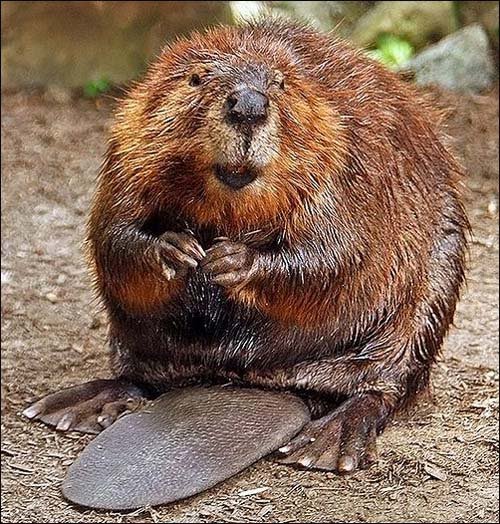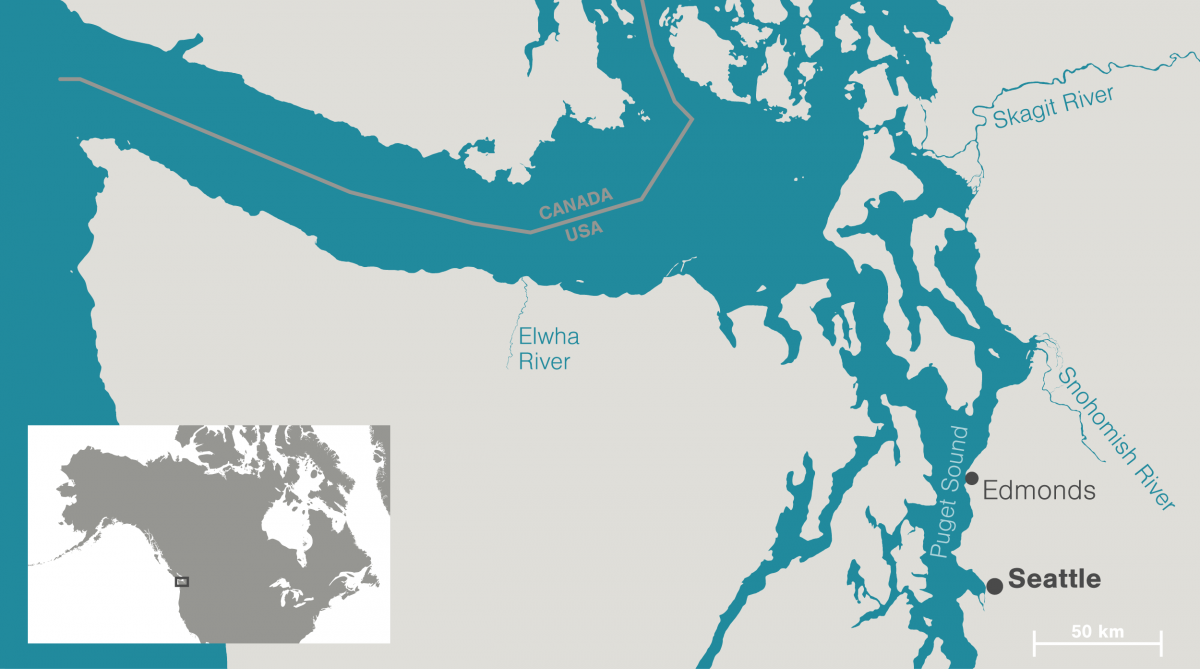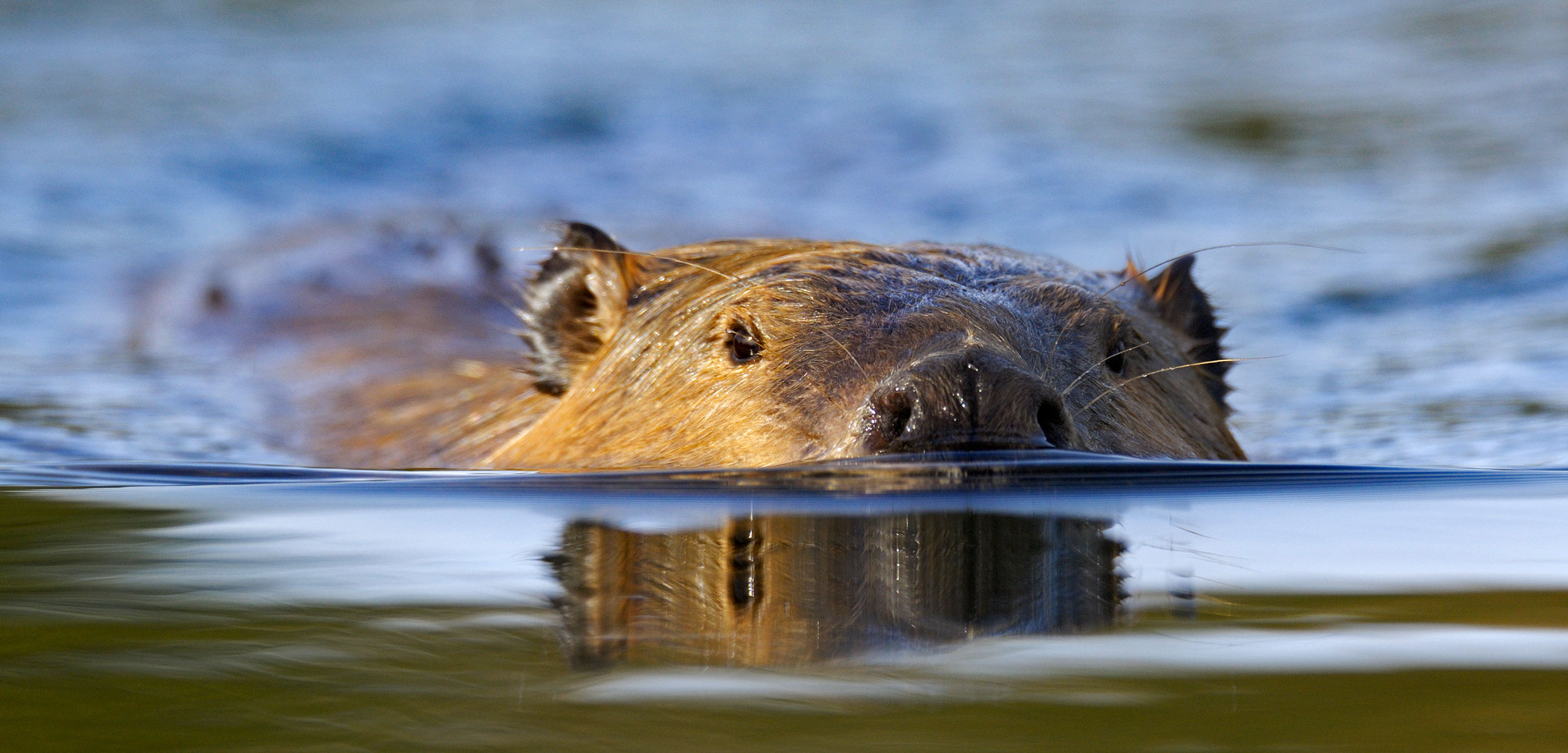
Most people associate the beaver, Castor canadensis, with fresh water—but it’s a coastal creature too.
Photo by George Sanker/NPL/Minden Pictures
Scientists have long overlooked beavers in the intertidal zone. Now they’re counting on the freshwater rodents to restore Washington’s coastal ecosystems.
Hakai Magazine
@hakaimagazine
The Gnawing Question of Saltwater Beavers
Coastal science and societies
Videos + Visuals
Youtube
 Most people associate the beaver, Castor canadensis, with fresh water—but it’s a coastal creature too. Photo by George Sanker/NPL/Minden Pictures
Most people associate the beaver, Castor canadensis, with fresh water—but it’s a coastal creature too. Photo by George Sanker/NPL/Minden Pictures
The Gnawing Question of Saltwater Beavers
Scientists have long overlooked beavers in the intertidal zone. Now they’re counting on the freshwater rodents to restore Washington’s coastal ecosystems.
Authored by
by Ben Goldfarb
Wordcount
January 29, 2019 | 3,000 words, about 15 minutes
Share this article
Stream or download audio For this article
This article is also available in audio format. Listen now, download, or subscribe to “Hakai Magazine Audio Edition” through your favorite podcast app.
Article body copy
The female beaver laying on a table in the exam room was nearly comatose, her whiskered face and nimble paws twitching with seizures. Bethany Groves, the attending wildlife veterinarian, had seen beavers before, many the victims of car strikes and dog attacks. Those patients tended to be feisty, snapping their orange, self-sharpening incisors—fortified with iron—at Groves’s hands. This 16-kilogram adult, though, had none of the species’ usual vigor. Within a day, the animal was dead.
Groves found a clue to the beaver’s demise in the circumstances of its death. Castor canadensis is, of course, a freshwater dweller, adapted to lakes and rivers and wetlands. Yet wildlife control officers had found this particular rodent rolling listlessly in the surf near a ferry terminal along the coast of Puget Sound, an inlet along the coast of Washington State.
On a hunch, Groves, who works for the Progressive Animal Welfare Society’s Wildlife Rehabilitation Center just outside Seattle, drew a blood sample. The beaver’s sodium level was a shocking 183 milliequivalents per liter, far above the normal concentration, typically 130 to 150 milliequivalents per liter. The animal, she suspected, had ingested enough seawater to induce salt toxicity.
One salt-poisoned animal might be dismissed as a lone misguided mariner. Since that February 2016 case, however, Groves has seen four more sick saltwater beavers. Each one has suffered the same symptoms—lethargy, seizures, and catastrophic sodium levels—and none has survived more than 24 hours.
“They’re found on the shoreline, often covered in sand—they literally look like they were just pulled out of the ocean,” Groves says. She has started IV drips on her paddle-tailed patients, attempting to rebalance their salt levels without success. Groves has preserved tissue samples from all five victims in formalin; when she reaches a half-dozen, she plans to send them to a pathology lab, which, she hopes, will confirm her diagnosis of salt toxicity. “The pathologist gets samples submitted from all over the world, yet this was totally unheard of to him,” she says.
Once hunted almost to extinction for hat-making, beavers are now found in lakes across North America. Development of their coastal habitat, however, has mostly erased beavers from the intertidal zone. Video by Pond5
Groves’s experience sheds some light on a curious phenomenon—that North America’s most iconic freshwater rodents frequently take to the ocean. Although the peer-reviewed literature is scant, there are many anecdotal accounts of brave beavers venturing to sea. After the Argentine government attempted to jump-start a fur trapping industry by introducing the rodents to Tierra del Fuego in 1946, for instance, beavers swiftly spread throughout the archipelago, eventually crossing the Strait of Magellan to the Patagonian mainland—a voyage of at least 2.4 kilometers. On Isle au Haut, 11 kilometers off the Maine coast, rangers captured photos of a bedraggled beaver in 2014.
Yet beavers aren’t just coastal wanderers, they’re also residents—potential health consequences be damned. Greg Hood, senior research scientist at the Skagit River System Cooperative in Washington, says biologists have overlooked beavers in the state’s tidal shrublands, a liminal zone washed twice daily by the ocean. Until recently, Hood adds, estuarine beavers were considered bizarre anomalies, when they were considered at all. “You don’t find what you don’t look for,” he says.
In freshwater environs, the dam builders are the ultimate keystone species, their ponds and wetlands furnishing habitat for creatures from mink frogs to wood ducks to moose. Hood’s research suggests beavers are equally indispensable along the coast, engineering deep pools for fish, including juvenile salmon, in estuaries plagued by habitat loss. Acknowledging the importance—indeed the existence—of coastal beavers might just be vital to re-creating a lost intertidal world: an ecosystem sculpted by rodent teeth, undone by human hands.
Among the best places to encounter coastal castors is the Qwuloolt estuary, the salt marsh that lies at the mouth of the Snohomish River, a 32-kilometer watercourse that wends from the Cascade mountains through verdant Puget Sound bottomlands. One summer morning, I kayak through the estuary with David Bailey, a biologist with the Tulalip Tribes, a Native sovereignty whose 8,900-hectare reservation lies just up the coast. Bailey and I paddle upstream against the outgoing tide, the air salty and rotten on my tongue. The endless flats are somber and ashen, pierced by skeletal spruces that tower over the plain like giant chess pieces.
Bailey works on the Tulalip Beaver Project, capturing troublemaking rodents around the greater Seattle area and relocating them to federal lands. Yet he and Molly Alves, a wildlife biologist with the Tribes, first encountered intertidal beavers in the Qwuloolt entirely by accident while conducting early-morning bird surveys. Beavers have since haunted the scientists’ visits to the estuary, often shattering its serenity with gunshot-like tail slaps, their signature alarm signals. “They’ll scare me half to death,” Bailey grumbles, dipping his paddle.
Scientists have long overlooked beavers in the intertidal zone. Now they’re counting on the freshwater rodents to restore Washington’s coastal ecosystems.
Hakai Magazine
@hakaimagazine
The Gnawing Question of Saltwater Beavers
Coastal science and societies
Videos + Visuals
Youtube

The Gnawing Question of Saltwater Beavers
Scientists have long overlooked beavers in the intertidal zone. Now they’re counting on the freshwater rodents to restore Washington’s coastal ecosystems.
Authored by
by Ben Goldfarb
Wordcount
January 29, 2019 | 3,000 words, about 15 minutes
Share this article
Stream or download audio For this article
This article is also available in audio format. Listen now, download, or subscribe to “Hakai Magazine Audio Edition” through your favorite podcast app.
Article body copy
The female beaver laying on a table in the exam room was nearly comatose, her whiskered face and nimble paws twitching with seizures. Bethany Groves, the attending wildlife veterinarian, had seen beavers before, many the victims of car strikes and dog attacks. Those patients tended to be feisty, snapping their orange, self-sharpening incisors—fortified with iron—at Groves’s hands. This 16-kilogram adult, though, had none of the species’ usual vigor. Within a day, the animal was dead.
Groves found a clue to the beaver’s demise in the circumstances of its death. Castor canadensis is, of course, a freshwater dweller, adapted to lakes and rivers and wetlands. Yet wildlife control officers had found this particular rodent rolling listlessly in the surf near a ferry terminal along the coast of Puget Sound, an inlet along the coast of Washington State.
On a hunch, Groves, who works for the Progressive Animal Welfare Society’s Wildlife Rehabilitation Center just outside Seattle, drew a blood sample. The beaver’s sodium level was a shocking 183 milliequivalents per liter, far above the normal concentration, typically 130 to 150 milliequivalents per liter. The animal, she suspected, had ingested enough seawater to induce salt toxicity.
One salt-poisoned animal might be dismissed as a lone misguided mariner. Since that February 2016 case, however, Groves has seen four more sick saltwater beavers. Each one has suffered the same symptoms—lethargy, seizures, and catastrophic sodium levels—and none has survived more than 24 hours.
“They’re found on the shoreline, often covered in sand—they literally look like they were just pulled out of the ocean,” Groves says. She has started IV drips on her paddle-tailed patients, attempting to rebalance their salt levels without success. Groves has preserved tissue samples from all five victims in formalin; when she reaches a half-dozen, she plans to send them to a pathology lab, which, she hopes, will confirm her diagnosis of salt toxicity. “The pathologist gets samples submitted from all over the world, yet this was totally unheard of to him,” she says.
Once hunted almost to extinction for hat-making, beavers are now found in lakes across North America. Development of their coastal habitat, however, has mostly erased beavers from the intertidal zone. Video by Pond5
Groves’s experience sheds some light on a curious phenomenon—that North America’s most iconic freshwater rodents frequently take to the ocean. Although the peer-reviewed literature is scant, there are many anecdotal accounts of brave beavers venturing to sea. After the Argentine government attempted to jump-start a fur trapping industry by introducing the rodents to Tierra del Fuego in 1946, for instance, beavers swiftly spread throughout the archipelago, eventually crossing the Strait of Magellan to the Patagonian mainland—a voyage of at least 2.4 kilometers. On Isle au Haut, 11 kilometers off the Maine coast, rangers captured photos of a bedraggled beaver in 2014.
Yet beavers aren’t just coastal wanderers, they’re also residents—potential health consequences be damned. Greg Hood, senior research scientist at the Skagit River System Cooperative in Washington, says biologists have overlooked beavers in the state’s tidal shrublands, a liminal zone washed twice daily by the ocean. Until recently, Hood adds, estuarine beavers were considered bizarre anomalies, when they were considered at all. “You don’t find what you don’t look for,” he says.
In freshwater environs, the dam builders are the ultimate keystone species, their ponds and wetlands furnishing habitat for creatures from mink frogs to wood ducks to moose. Hood’s research suggests beavers are equally indispensable along the coast, engineering deep pools for fish, including juvenile salmon, in estuaries plagued by habitat loss. Acknowledging the importance—indeed the existence—of coastal beavers might just be vital to re-creating a lost intertidal world: an ecosystem sculpted by rodent teeth, undone by human hands.
Among the best places to encounter coastal castors is the Qwuloolt estuary, the salt marsh that lies at the mouth of the Snohomish River, a 32-kilometer watercourse that wends from the Cascade mountains through verdant Puget Sound bottomlands. One summer morning, I kayak through the estuary with David Bailey, a biologist with the Tulalip Tribes, a Native sovereignty whose 8,900-hectare reservation lies just up the coast. Bailey and I paddle upstream against the outgoing tide, the air salty and rotten on my tongue. The endless flats are somber and ashen, pierced by skeletal spruces that tower over the plain like giant chess pieces.
Bailey works on the Tulalip Beaver Project, capturing troublemaking rodents around the greater Seattle area and relocating them to federal lands. Yet he and Molly Alves, a wildlife biologist with the Tribes, first encountered intertidal beavers in the Qwuloolt entirely by accident while conducting early-morning bird surveys. Beavers have since haunted the scientists’ visits to the estuary, often shattering its serenity with gunshot-like tail slaps, their signature alarm signals. “They’ll scare me half to death,” Bailey grumbles, dipping his paddle.
Illustration by Mark Garrison
After 15 minutes, we arrive at a channel, a thin seep of fresh water that courses down to the estuary through a gash in the floodplain. We pull onto the wedge of gloop that passes for a beach and clamber from our kayaks. I immediately sink mid-thigh in the slop, where, despite vigorous thrashing, I remain, a mammoth trapped in the La Brea tar pits. With a mighty lunge, I fall forward, shedding my mud-cemented waders like a chrysalis. Now shoeless and stripped to jeans, I lie down to distribute my weight across the jello-ish ground and flop, pinniped-style, onto a stable tuft of marsh grass. An osprey taunts me with a whistle.
“That’s probably why nobody studies these beavers,” Bailey quips from the safety of high ground. “Because it sucks.”
We slog up the steep-sided channel, slop oozing through my socks with each difficult step, into the tidal shrub zone—the narrow band of estuarine habitat that’s elevated just enough to sustain woody plants like willows but too soggy to support most large trees. At last we reach the beavers’ stronghold. I am underwhelmed. A ramshackle dam of sticks and mud, perhaps two meters wide, spans a trickle of murky water. Behind it swirls a stagnant pool clotted with algae. Compared with majestic beaver-built bulwarks I’ve seen elsewhere, it’s a sad specimen.
What this dam lacks in aesthetics, however, it makes up for in hydraulic brilliance. With the tide out, Bailey explains, this dam holds back water that would otherwise run to the sea, forming a deep bathtub in which beavers shelter from black bears and coyotes. Come back six hours later, and the returning tide will have filled this channel, completely submerging the dam. “You could kayak right over the top of it and not even know it was there,” Bailey says.
In other words, the estuary’s beavers seem to anticipate tidal fluctuations, erecting their dams in places that ensure water remains even when the tide reaches its ebb. The US Army Corps of Engineers could hardly have done it better.
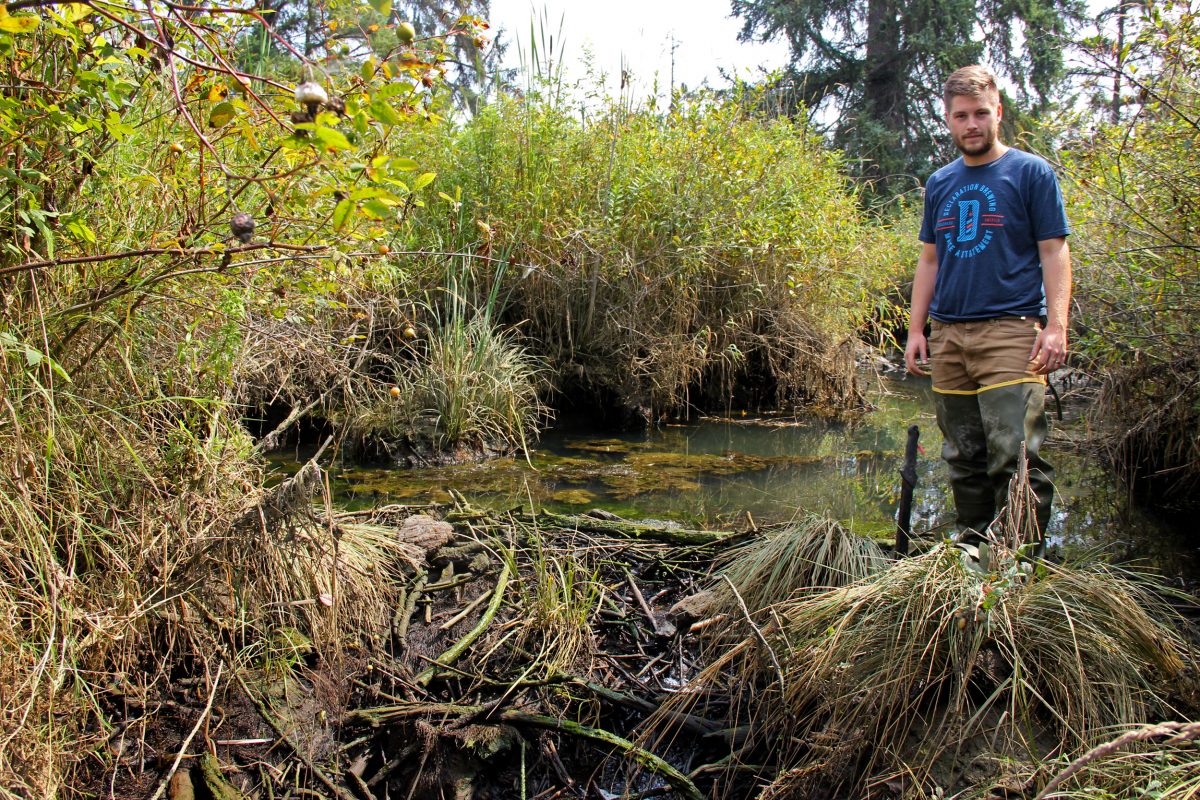
David Bailey, a biologist with the Tulalip Tribes, stands next to a beaver dam exposed at low tide on the Snohomish River in Washington State. Photo by Ben Goldfarb
We wander the floodplain’s labyrinthine channels, fighting through tangles of wild rose that shred my socks and slash my forearms—and serve as Fort Beaver’s defenses. Burrows and dens riddle the banks, their entrances barricaded with microdams: stick piles, cemented with mud, perhaps intended to keep the tunnels inundated during low tide and thus impenetrable to intruders.
“It’s almost like they’re engaging different areas of the estuary at different tidal levels,” Bailey marvels. “It’s a whole multistory housing complex.” At the complex’s hub is the main lodge, excavated beneath the arched roots of a dying spruce and capped with a mound of dried sedge. The elaborate compound recalls an ant or termite colony—the sophisticated development of an inscrutable intelligence. Though I’m none too pleased with my muddy, shoeless condition, I have to admit I’m impressed with the beavers’ ingenuity.
What little we know about the architecture of intertidal beavers we owe to Greg Hood.
Hood works on the Skagit, a river that, like the Snohomish, spills from the Cascades to Puget Sound, relaxing into a broad estuary carpeted in willow, sweet gale, and wild rose. Like Bailey, Hood stumbled upon intertidal beavers while studying something else entirely: the role of downed logs in the Skagit ecosystem. The delta’s channels, Hood noticed in the mid-2000s, were chockablock with beaver dams and lodges. Beavers? In the intertidal? Hood reviewed the literature and confirmed his suspicions: estuarine beavers had escaped scientific attention.
Only humans rival beavers when it comes to engineering prowess. Video by Pond5
Hood decided to fill the gap. He surveyed 25 kilometers of Skagit tidal shrublands, bushwhacking through mud and brush so thick that he often located lodges only by stepping on them. The exhausting, mucky research was worth the trouble. Altogether, Hood found 125 beaver dams and 14 lodges, construction densities that rival most rivers. Beavers were thriving where no prior scientist had thought to look for them.
By engineering the intertidal to their own satisfaction, Hood discovered, the keystone rodents were sustaining other coastal residents as well. When he dragged seine nets through their pools, he found them teeming with stickleback, prickly sculpin, lamprey, and juvenile chinook salmon. At low tide, when receding waters would otherwise have flushed baby salmon toward waiting mergansers and kingfishers, Hood counted over three times more chinook in beaver pools than in other channels, suggesting that young fish were sheltering in beaver-built pockets until high tide submerged the marsh once more. Indeed, predatory great blue herons seemed to avoid beavery spots, where deep water and dense shrubs thwarted the broad-winged wading birds.
“The dammed areas can be over a meter deep at low tide, whereas the water might be just an inch or two deep in channels that aren’t dammed,” Hood explains. To vulnerable fish, beavers were serving as generous landlords, furnishing rent-free tidal refuges.
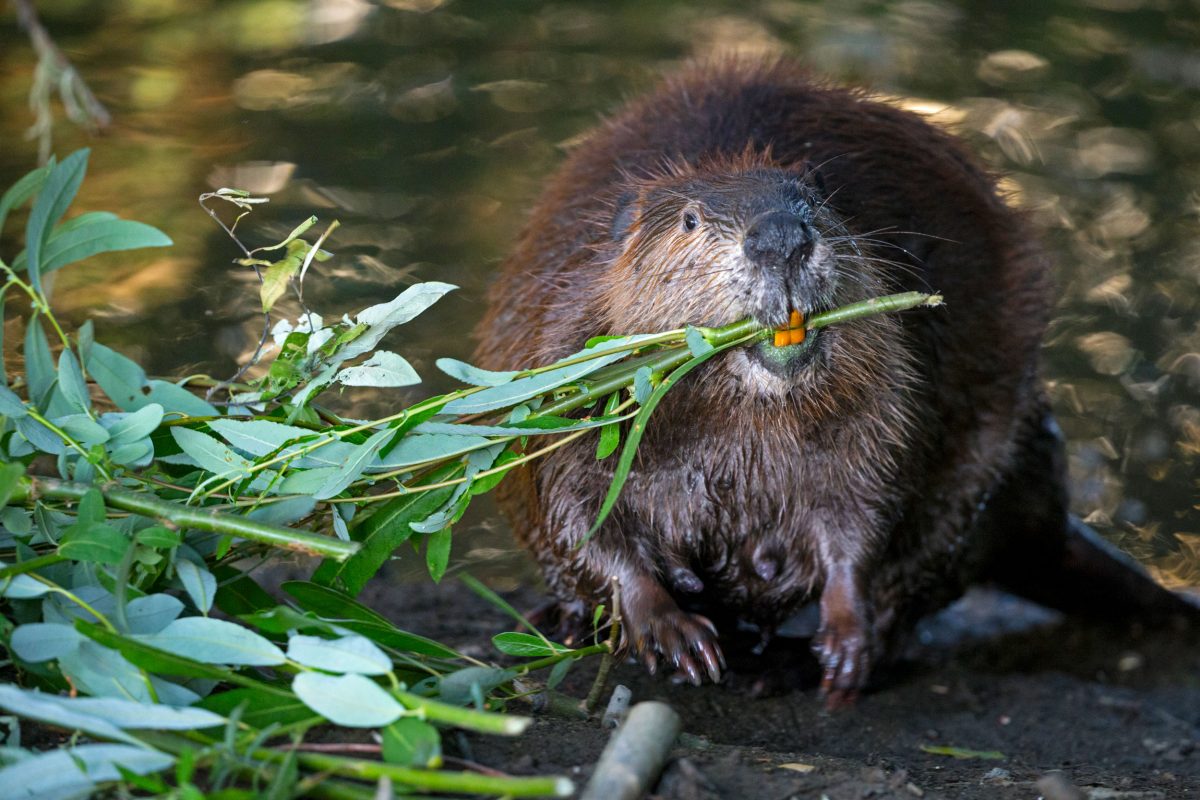
Beavers’ diets consist of the inner bark of trees such as willow (above), as well as cottonwood, aspen, alder, and other deciduous species. Photo by Suzi Eszterhas/Minden Pictures
When, in 2012, Hood published a paper describing the intertidal beaver phenomenon, the scientific community took surprised note. Colleagues who had previously ignored beavers now told him about sightings along the Oregon coast, the Columbia River estuary, and other Puget Sound tidal marshes. But if awareness is truly spreading, it’s moving slowly. “I’ll get calls from the Port of Tacoma being like, ‘Uh, why is this beaver swimming in Puget Sound?’” says Molly Alves from the Tulalip Tribes. “‘Is something wrong with him?’”
Maybe. Hood’s discovery that C. canadensis is shockingly prolific in the intertidal zone is tough to square with the rodents evidently killed by gulping seawater. How is it that some beavers flourish on the coast while others perish? Perhaps estuarine beavers typically dwell close enough to river mouths to access fresh water but occasionally stray too far to sea while dispersing between rivers, like foolhardy Icaruses of the intertidal. Or maybe some individuals are simply more salt-tolerant than others.
“How do these beavers cope with the salt water around them?” wonders Bethany Groves, the wildlife vet. “We just don’t know enough about their physiology yet to know.”
A week after my slog through the Snohomish, I head to the Olympic Peninsula for a more leisurely beaver tour with Anne Shaffer, director of the Coastal Watershed Institute—one of the few groups to champion the cause of coastal castorids. I meet Shaffer and her husband, David Parks, a hydrogeologist with the Washington State Department of Natural Resources, near the mouth of the Elwha River. We stroll alongside a brackish off-channel pond wreathed in morning fog, a beaver lodge erupting from its center like a volcanic island. A dark-sand beach divides the pond from the Juan de Fuca Strait, where clouds of western gulls snatch herring and smelt. “Looks like there’s quite the smorgasbord out there,” says Parks, gazing to sea.
Our attention this morning, however, is directed to the intertidal zone. Veering west, we squelch onto a floodplain lightly forested in alders, their trunks inscribed with beaver scars. Stands of willows, a beaver delicacy, have been whittled to stakes. The Elwha’s wooded floodplain is veined with channels, their banks pocked with beaver-dug burrows below the waterline. Salmon fry flee into the tunnels’ dark entrances at our approach. A few untidy dams interrupt one narrow canal. I ask Shaffer if the beavers built the structures to maintain deep water at low tide, as they do in the Skagit.
“I’d assume so,” she says, laughing. “You’d have to ask the beavers.”
Beavers busy in the intertidal zone create habitat for other species, including salmon, steelhead trout, and other fish. Video courtesy of the Coastal Watershed Institute
That beavers are sculpting this nearshore habitat is among Shaffer’s greatest joys. Shaffer, Parks, and a few others founded the Coastal Watershed Institute in 1996 to advocate for the protection and study of the Olympic Peninsula’s northern shoreline, which lies beyond the jurisdiction of Olympic National Park. At the time, the Elwha’s nearshore was a ghost of itself. Two gargantuan dams, the Elwha Dam and the Glines Canyon Dam, had trapped sediment upriver for decades, starving the estuary of silt and sand. The few walkers who visited the Elwha’s mouth found only forbidding, wave-blasted cobble.
In 2001, the US government, in response to pressure from the Lower Elwha Klallam Tribe, purchased the dams with the intent of blowing them up—the largest dam removal project in history. To Shaffer’s dismay, none of the project’s designers seemed much interested in the coastline. The demolition’s budget funded biological research around the old reservoir sites, but neglected to allocate money for studying the nearshore, eight kilometers distant. At planning meetings, Shaffer often found herself last on the agenda. “I’d be talking to people as they were walking out the door for their lunch break,” she says.
When, in 2011, the government began blasting away the dams, Shaffer was instantly vindicated. As the reservoirs drained, millions of cubic meters of mocha-colored sediment raced downstream, settling at the river’s mouth. With the Elwha freed, a 40-hectare wedge of beaches, sandbars, and floodplains reemerged—a coastal kingdom built by silt. “Few people are excited to see a big pile of sand,” the Seattle Times reported, “unless it’s a big pile of sand at the mouth of the Elwha River.”
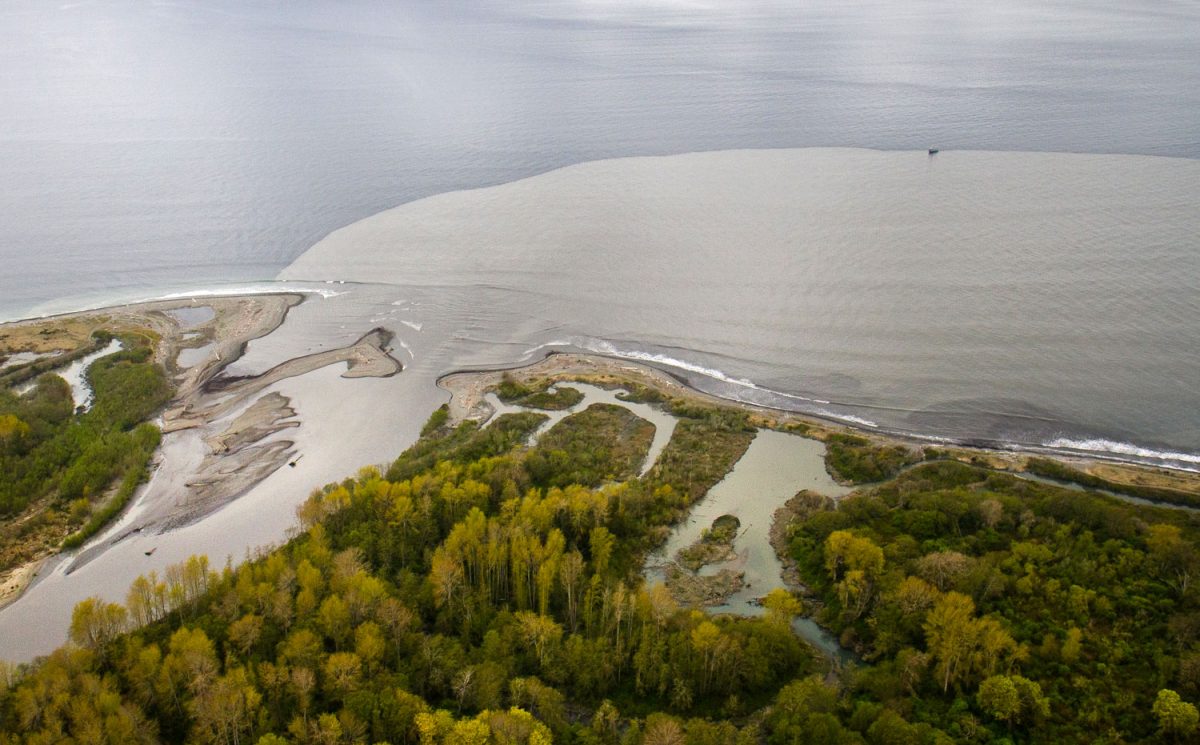
Elwha River sediment mixes with the coastal waters of the Juan de Fuca Strait in Washington State. Photo by John Felis/USGS
No one was more excited about the big sand pile than the Elwha’s beavers. The river’s beavers, a hardy lot, had long endured the incursions of human engineers: four years before the concrete dams were demolished, Robert Knapp, a master’s student at Western Washington University, had found beaver-gnawed willow lining the river’s lower reaches. As the Elwha’s nearshore blossomed, though, the buck-toothed builders discovered a new outlet for their talents, digging canals, forming ponds, and damming the tidal channels that cut through new layers of deposited silt. “Once all this vegetation grew back, they really started settling in,” Shaffer says, waving a hand at the floodplain’s wall of alder.
“It’s like a beaver supermarket in here,” Parks adds.
Like the Skagit River’s fry, the Elwha’s resurgent salmon may have beavers to thank for a fin up. If construction is the rodents’ most notable skill, excavation is a close second. Beavers interlace their compounds with foraging canals, aqueducts they use to access and transport trees without risking overland travel. In one 2014 study, Glynnis Hood—no relation to Greg—found that beavers in a single Alberta park dug around 40 kilometers of canals, displacing nearly nine Olympic swimming pools of gunk with their dexterous paws. In the Elwha nearshore, Shaffer believes their relentless digging has prevented ponds and channels from being smothered by the rejuvenated sediment supply, maintaining open pools for juvenile salmon, steelhead, and cutthroat trout.
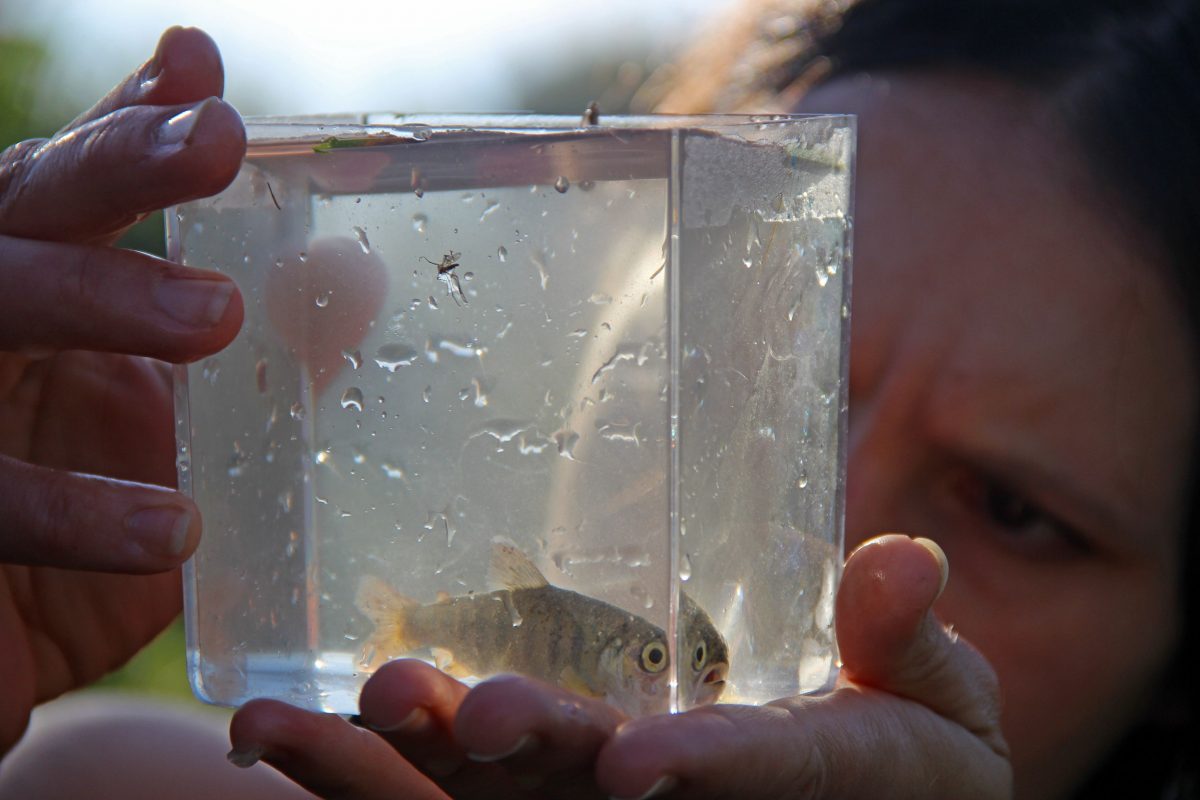
Danielle Zitomer, habitat biologist with the Washington Department of Fish & Wildlife, checks out a salmon fry from the Elwha River, a formerly dammed waterway now friendlier to fish thanks in part to intertidal beavers. Photo by Ben Goldfarb
“From our perspective,” Shaffer says, “they’re such an important link.”
These are boom times in the beaver restoration business. In arid ecosystems like Nevada and central Oregon, the rodents are increasingly perceived as hydrological saviors—capable of creating reservoirs for ranchers, dampening the spread of wildfire, and, by keeping streams cold and hydrated in the face of drought, even helping the warming West adapt to climate change.
Among coastal scientists, however, beaver fever has yet to spread beyond Greg Hood. He still has questions about the beaver’s intertidal role—in particular, how the organic matter trapped behind beaver dams flows through coastal food webs. “You’ve got these channels that are full of decaying leaves, sticks, and detritus, which tells you that we’ve got a lot more organic material and a lot more detritivores feeding off it,” he says. But studying those connections requires money, and grant-making institutions are little interested in funding research into a creature whose very presence is scarcely acknowledged.
To Hood, the paucity of attention suggests sampling bias. Beaver biologists focus on fresh water, where their subjects usually hang out. Coastal ecologists, meanwhile, gravitate toward sedge-filled lowlands, the dominant habitat in most Washington estuaries. As for the tidal shrub zone, that narrow, impregnable band of sweet gale and wild rose where beavers flourish and scientists fear to tread? It’s neglected—or it simply no longer exists, drained and diked and cleared by farmers a century ago. In the Skagit Delta, 95 percent of tidal shrublands have been destroyed.
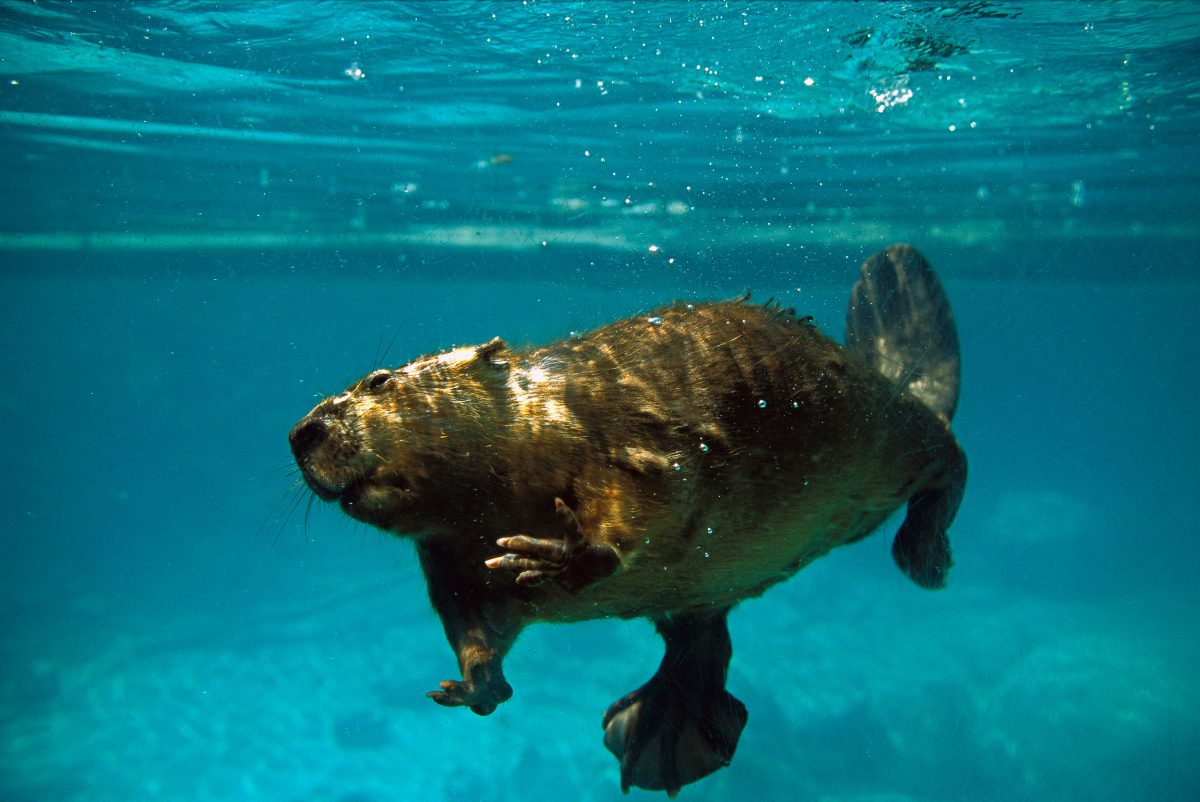
Beavers are semiaquatic rodents native to North America. Lately, scientists have come to recognize their important role in creating coastal fish habitat. Photo by Konrad Wothe/Minden Pictures
“It’s a rare habitat type, and people don’t spend much time in rare habitats,” Hood laments.
In a sense, then, our coastal beaver blind spot is an artifact of history—a form of “ecological amnesia,” as Frances Backhouse put it in her book Once They Were Hats. Just as sun-blotting flocks of passenger pigeons and earth-shaking herds of bison vanished from our skies and prairies, the combination of marsh drainage and trapping wiped beavers from our coastlines and, eventually, our memories.
“There are countless examples where we don’t know how ecosystems are supposed to work,” Hood says. “The landscape has been radically altered, and the way animals use the landscape has been radically altered.”
The estuaries of the Skagit, the Snohomish, and the Elwha are more than beaver bastions—they’re portals to a former paradise, a salmonid haven constructed and maintained by a passel of rodents. As for how those intertidal architects subsist in the salt—well, as Aldo Leopold once wrote of waterfowl, “What a dull world if we knew all about geese!” Some beavery mysteries, perhaps, are destined to remain unsolved.
Author bio
Ben Goldfarb is an environmental journalist whose work has appeared in Science, Mother Jones, Orion Magazine, The Guardian, and many other publications. He is the author of Eager: The Surprising, Secret Life of Beavers and Why They Matter. He’s also an angler, scuba diver, and nudibranch aficionado.
LINK: https://www.hakaimagazine.com/features/the-gnawing-question-of-saltwater-beavers/
